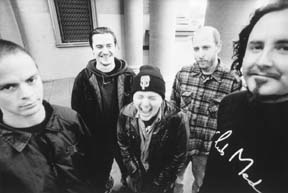

TREY SPRUANCE's description of the equipment setup at Mr. Bungle shows...
"I use a POD direct, going through a spring reverb for the clean sound - and a Marshall JMP1 direct for the dirty. That's it - totally bare-bones. I know the guitar is a pretty visual instrument and all, but literally %95 of what I do in the band has to do with production, programming and keyboard arranging - there's very little time to fuck around with the guitar.
"All of those keyboards (Jeff/Roto's, and Bar's) are hooked up via MIDI to my K2500. There are three to five total keymaps per song (one for each keyboard, sometimes two on Roto's channel, and three in the case of Robots). Some of these keymaps are 32 layers deep with different up to 38 programmed sounds and samples on ONE KEYMAP. Each keymap is divided up into "zones" where these parts can be grouped strategically, and played once all the locations are memorized.
"... For instance, on Sweet Charity, Roto's Keyboard (triggering Midi Channel 1 on mine) accesses the appropriate keymap (assigned to his channel). The first two notes (E0 and F0) are the vibes chords, sampled from our record. The F#, G and G# are the pedal steel chords that play simultaneously with the vibes, but in different combinations. Ends of samples are looped and then release is smoothed out so things won't be choppy. After depressing a Midi function switch (which activates one of his two keymaps in the song) he switches to the uppermost octave to play the string chords (sounds I programmed played naturally as chords) at the first "save me" part. Bar comes in (Midi Channel 2) on his upper octave where I put a french horn sound for him to play the f horn line. When the chorus comes, I come in (Midi Channel 3) on low octaves piano (L) and high piano chords (R), Bar is playing a Harpsichord sound (R) and the Timpani counter-line (L), and Roto is now playing the French Horn line. Next, Roto covers the high string hold, and comes in playing Glockenspiel/organ sound (bossa part) after switching the Midi function key back to the other keymap on his Channel (1). Bar and I attend to other perc/guitar duties, as we will do occasionally. Next, it's Pedal Steel samples on Roto's channel for the "perfect photographs" part - the samples are broken up so he can rhythmically adjust to the idiosyncracies of Mike and Willie during the part, and not sound like some bullshit cyber music. Next, I come in with a low piano (L) and high strings playing chords (R) as Roto continues the broken-up, looped and tapered Pedal Steel Samples playing different voicings of the same chords. Then it's the chorus again - but of course in a very different key, thus a wider "zone" of harpsichord/Timpani (Bar) & french horn (Roto) than before. On to the "save me" part, where Roto once again must access the strings on the other keymap on his channel (1) by depressing his Midi function key. At the end of this section, on his last chord, he comes in with some Tubular Bells and ends up playing choir chords as well - all three at once at one point - while Bar leads the next part (chorus) in with the Timpani, and it's back to the Piano for me, French Horn for Roto and Harpsichord and Timpani for Bar. Modulated, and therefore 'zone-expanded', of course.
"That's one song - to complicate matters, we all have to sing during all this, and switch off with other instruments, like all of Bar's percussion parts. Yeah, there are a couple of little guitar parts in there I gotta play, but not enough for me to think about too much - it's so fucking EASY in comparasin. Pretty much every song is like this.
"I haven't even brought up the routing: 8 seperate outputs - 1 & 2 for played parts like strings/organs/pianos; 3 & 4 for samples; 5 & 6 for "effected" parts (one side goes through spring reverb - digital effects can suck me) for things like French Horns, oboes and drenched piano or string parts. Then there's the EMU (7 & 8) for all the older stuff (debut and Disco Volante), which is controlled via my keyboard and Bar's (through mine). Roto disables Midi on these songs and plays internal sounds on his keyboard - he also has to switch two AB boxes that switch between his keyboard's L/R and 1 and 2 from my K2500 (this saves channel space - we are a 40 channel live band, and that's stripped down, believe me). Both keyboard brains have to be loaded. Sometimes, if we construct the set right I can load one while the other is engaged, to save time. Luckily, when we run out of hands to do things, Mike can cover some of the parts on his sampler - these are usually sound effect parts. Some of the sounds on his little Roland keyboard are pretty good, so if he's not already "doing something else" (singing doesn't count) we can usually find a way to divy up the parts so that he can cover something.
"If you think this all sounds crazy, wait until I post California album production notes and full live show arrangement details at WoM. It will happen soon enough.
"Thanks for caring enough to wade through all this junk,.. jeezus!"
T